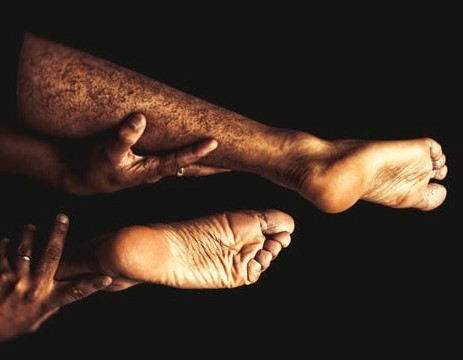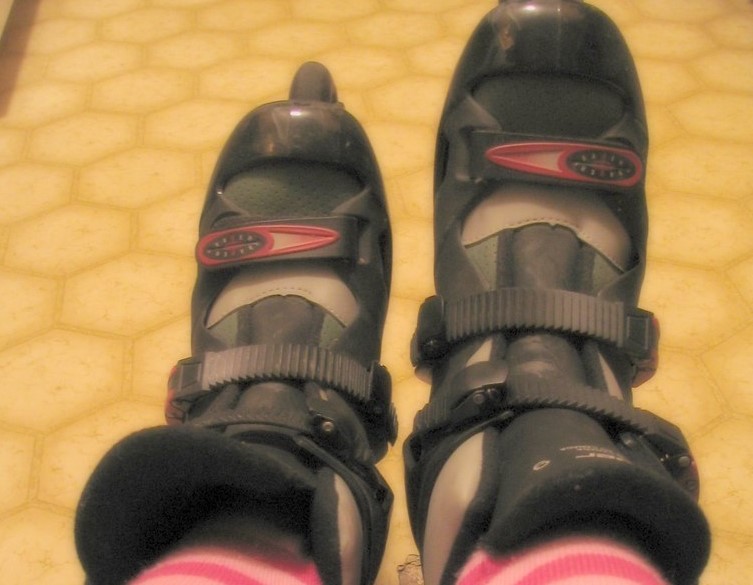
It’s not unheard of for someone to buy brand new skates and suffer pain after skating for a few minutes. I wanted to create a short guide to all the reasons you’re experiencing pain when inline skating and what to do about it.
So, why do your rollerblades hurt when you skate? Your rollerblades hurt for one or more of several reasons: skates too big, too small, wrong shape for your feet, you’re skating with an odd form, your muscles are not developed enough, you have an existing medical condition, some combination of these, or you simply need to break the skates in.
Let’s dive into the different causes to find out why rollerblading can cause you pain and, crucially, what you can do to reduce the pain or make it go away entirely.
What Is Causing the Pain When I Inline Skate?
It can be quite worrying when you start to suffer any pain from a physical activity, but it helps to understand what’s causing it so you can start to do something about it, and to make sure you don’t make it worse.
Pain might be coming for one or more of these reasons:
- Ill-fitting skates
- Poor form
- You just need to get used to skating and/or break in the skate
- Too high impact
- A prior medical condition (less likely)
In many cases, if you have just started skating and your feet and ankles hurt a little bit – but not enormously – it may just be the fact that you are not used to using your ankles and feet within a boot, like you do when you skate. It may just be a case of getting used to the equipment and the unnatural movement.
You may just need to break in the skate. If you’ve gone out for one skate and afterwards your feet or ankle hurts mildly, this could be a possibility. Some skates come tight and get loser as you wear them in after a while.
BUT…. If the pain doesn’t go away after a few sessions, you may have to look towards the other possibilities.
Topping the list:
Ill-fitting skates.
Are your skates too small, or too big? Your toes should be near the end but not touching them. The boot should be wide enough for your feet. The boot should be tight but not blood-constrictingly tight. If it’s a brand new boot, sometimes you may expect it to be a bit tight as you have to wear in the inner sole.
If you skate five times, and every time you’re in pain, then chances are the skates aren’t the perfect fit. It might be compressing on your ankle, or too tight around your foot. You can try to loosen the skate straps off slightly, or as mentioned above, skate a few times and see if it gets better.
Separately… another possibility is that you are unaccustomed to using those muscles:
If you asked a podiatrist, they would have a comprehensive list of causes of the pain. Much of it might be related to strain and vibration along the ligaments (plantar fascia) that maintain the arch of the foot, and to the unaccustomed workload on some of the small foot muscles.
In addition, compression of the mid-foot can be an issue for many skaters. Some pain may go away as it’s just your foot and ankle getting used to a weird movement and perhaps after a few sessions it disappears, whilst some other pain from something like rubbing or a pre-existing injury can get worse and worse.
So, what should you do in each case?
- Skates don’t fit: get a new inner sole or new skates that fit. See below for further information on how to fix this.
- Skating with poor form: change your form in a couple of specific ways, see below.
- Prior medical condition: understand what it is, and the ways you can change your skating or form to help, see below.
- Muscles aren’t developed enough: develop them (see below)
- Skating too strenuous: this one is easy, right? If you know this is the cause, take it easier, reduce the length of time, and speed you skate.
Pain When Rollerblading – Different Causes of Discomfort
Ankle Issues
Ankle injuries are the most common skating injury. Your body is supported by your ankle muscles when you skate. If you have weak ankles, you have less support, and you can feel unsteady on your skates and end up putting more pressure on the sole of your foot. If your legs feel tired after your session it can often be weak ankles. The biggest pain can come from twisting or rolling an ankle.
An overuse of the ankle tendon results in little tears of the tissue, known as anchilles tendonitis.
Another overuse injury is a stress fracture, which involves the bone.
These overuse issues can come from simply skating too strenuously, or doing so in a poor fitting boot, in addition to your muscles not being developed enough.
Other less common causes include osteoarthritis and rheumatoid arthritis.
Heel Issues
Heel issues are also quite common and can result in pain on the back front or bottom of the heel. This ranges from irritation and inflammation of the large tendon in the back of the ankle (achilles tendonitis, mentioned above).
The tissue that forms the arch of the sole of your foot can also become inflamed, causing plantar fasciitis.
Another heel issue is bursitis of the heel, which comes from many repetitions of a movement or excessive pressure over an extended period of time. Again this could have a couple of causes when skating such as doing too much or a poor fitting skate or both.
Excess pronation occurs when the ankle rolls too far inward.
A heel spur is when a hook of bone forms on the heel bone.
Back Pain From Skating
Although not technically your feet, ankles and the part of your body your rollerblades are in direct contact with, this is also a possibility that we can briefly touch on.
Why does your back hurt when you are rollerblading? It’s quite common for people to suffer lower back pain after skating for a short while and there are a couple of reasons for this.
lower back muscles not being strong enough – this will go away as you start to engage your core (think of tensing your inner stomach), and as these stabilising muscles build up over time skating.
Don’t worry about having a super straight back, let it arch a little bit like a cat so it’s a bit relaxed forward.
Try varying your position by bending your knees more or less. You can be too low which can put pressure, but you can also be too upright. See what works.
Corns and Calluses
Corns and calluses are hard, thick parts of your skin that are caused by friction. They can be painful but they’re not often serious. Corns are small lumps of hard skin, almost cone-shaped, whilst calluses are larger patches of rough thick skin.
They’re caused by pressure or rubbing or friction on the skin and come from other activities as well like lifting heavy weights, or even playing a musical instrument (for your hands), or wearing skates that are the wrong size (!), or not wearing socks with skates.
Bunions and Bunionettes
Another common source are bunions on the big toe, a deformity on the inside foot near the base of the big toe caused by wearing tight fitting footwear, or an inherited structural defect, stress on your foot, or a medical condition such as arthritis.
Bunionettes are like bunions but on the outside of your foot, a prominence of the fifth metatarsal bone at the base of the little toe.
Flat Feet and High Arches
Strained muscles and connecting ligaments can be an issue when you have flat feet, where your arches are flattened out. This can cause pain in skaters as it can in other activities. Most are born with flat feet but an adults arches can also fall. Conversely, high arches “hollow feet” can cause problems too and more people have hollow feet than have flat feet.
Your Skates Don’t Fit Properly… How To Tell
If you feel pain every time you skate it could be a sizing issue with your boot, either it is too long, too short, too narrow, or some other feature is causing an issue.

Are my skates too small?
Wearing the skate you should be able to feel if it’s so tight it reaches the level of pain. The best way is to try on other skates and see how they compare.
Wearing a skate too small can lead to ingrown toenails, blisters, calluses, and potentially cause your arch to straighten. These are all uncomfortable.
With children, this can cause malformation in the foot if they were a too small skate repeatedly. So be careful to adjust the skate size as they grow.
Are my skates too big?
Blisters, hammertoes, bunions and calluses can come from the friction caused by having a boot that is too big for you.
With children, parents sometimes purchase a pair of skates too big so the kid grows into it, which for some parents has worked. But often in do soing, and shoving in an extra pair of socks, some pain through blisters can come about if this sock moves and rubs. Can also cause sweaty feet of course.
The Right Size of Skates For Adults
When you first try a pair on you should be just able to touch the front of the skate boot, just barely, with your toes. Absolutely your toes should not be crunched up. You foot should be snug but not uncomfortable. Although it is worth noting that once you “break in” a skate – the process of skating into it until the sock and boot gets worn down to be less stiff and more flexible – you could gain about half a size from when you initially try them on. After they have been broken in, your foot should slide in nicely.
The Right Size of Skates For Kids
Do the pen test. Get the child to put on the skate loosely and bend leg forward, giving you access to back of foot, slide the pen, a good fit is one pen width (or pencil) with no wiggle room for the pencil.
What Can I Do To Prevent Pain?
General solutions to preventing or addressing pain in rollerblading include getting good fitting skates; decreasing the vibration you sustain either by skating on smoother surfaces or changing your skates so they have improved shock absorption; having better support for your ankle inside the skate; have a more extensive warm up; or don’t have the skate so tight over the midfoot (probably, again, by getting better fitting skates).
Revisit these because it’s likely to be fixed through one of those.
The first step is checking you have a good fitting skate for the size and shape of your foot.
You can purchase orthotic footbed insert to help align the foot properly. You can get custom fittings and prescriptions for a special skate insert. If your ankle or foot issues are severe you should have it treated by a podiatrist, or primary care physician.
With corns and calluses: whatever you do, don’t try and cut them off and try not to aggravate them by activity like skating long distances, or by wearing high heels or going barefoot. Instead you should wear thick cushioned socks, use inserts, soak corns and calluses in warm water to soften them, regularly use a pumice stone or foot file to remove hard skin, and moisturise to help keep skin soft.
If your foot likes arch supopport and the skate tends to flatten your foot, this can be fixed with an arch support.
However it should be noted that skates with lots of padding in may reduce circulation in your foot, so be sure to shift weight from foot to foot instead of skating on both feet all the time.
If you skates are too tight, continuing to skate can cause a neuroma (growth on the nerve near the toes), and you might need surgery to remove it. One tip, aside from well fitting skates, is to keep the lower portion of your boots laced loosely, while keeping the top portion tight. Or, you could get a pair of heat mouldable so you get the fit you require. You may have a wide foot bed, but narrow in the heel, or some combination of aspects of your foot that need to be catered for.
If you suffer from a burning sensation it may be down to a nerve from the boot being too narrow, so you could try a new boot. If you’re a woman you could consider the wider men’s boots if this occurs.
Are You Unconsciously Curling Your Toes When You Skate?
If you are getting a burning sensation, you could be unconsciously lifting your toes up, curling, or scrunching them, especially when slowing or turning. This is using the small muscles within your foot. If you get pain in your shins while skating, this may be the reason reason why. So, you have to make sure your feet and especially your toes are relaxed by getting in a better skating position, probably by moving your bum forwards a little way. Unless you’re doing slalom, you should really only be using your leg, torso and body muscles to skate.
One way to check your skating position is: feet parallel and hip distance apart, stand up in bare feet. Bend your knees but keep your back completely straight, no curve in your back. At this point your knee caps should be over your toes and you should be able to feel the weight in the front half of the foot. The next next step is key to seeing what’s wrong. Keeping your knees bent and back straight, push your bum backwards and feel what happens to your toes. The weight, being shifted back, brings the toes up. You may feel a strain in the shins as this happens. So this is why your toes are coming up. To fix this focus on getting the weight distribution over your foot better. Reducing speed can help you learn this. Pay attention to the weight on your feet.
You can also constantly move the toes, and resist curling.
Check your ankle support is secure enough. It can help reduce mid-foot pressure during skating.
When it comes to fit, some people have bought longer skates than sizing would suggest as it offers more mid-room, then it’s possible to fill the empty space at the front with foam.
Special socks can help. Thorlo inline skating shops are one option.
Use softer wheels to help with vibration. However they will wear faster. This goes for skating on smoother surfaces and skating with skates with more shock absorbing action. High performance skates made for speed with carbon frames and aluminium frame clips and light boots might transmit more road vibration, by the way.
Stretching well: stretch the calf muscle and foot prior to skating, then skate first 15 minutes with loose laces or mid-buckle unlatched allowing the foot to warm up, gradually tightening the skate as the foot warms up. Some people can feel a lack of blood perfusion to the distal foot from a tight mid-boot.
Related Questions
What Size Skates Should I Get If I Have A Wide Foot? Sometimes buying a size half larger than your standard shoe size, perhaps with K2 and Rollerblade brand, can help if you have a wider foot. Of course, just buying a better quality of skate will help/
How Long Does It Take To Break A Pair of Skates In? It varies on how much you’re skating with them but from a few days to a couple of weeks.

